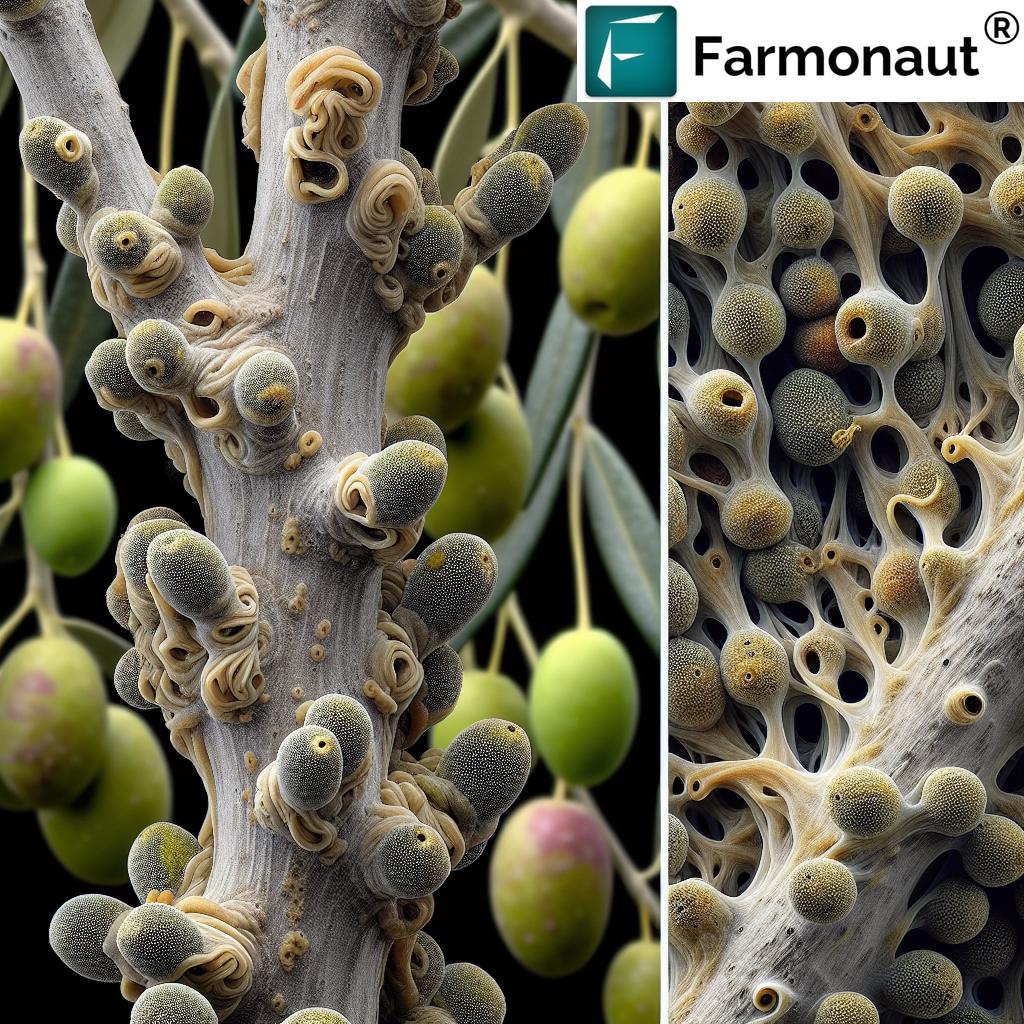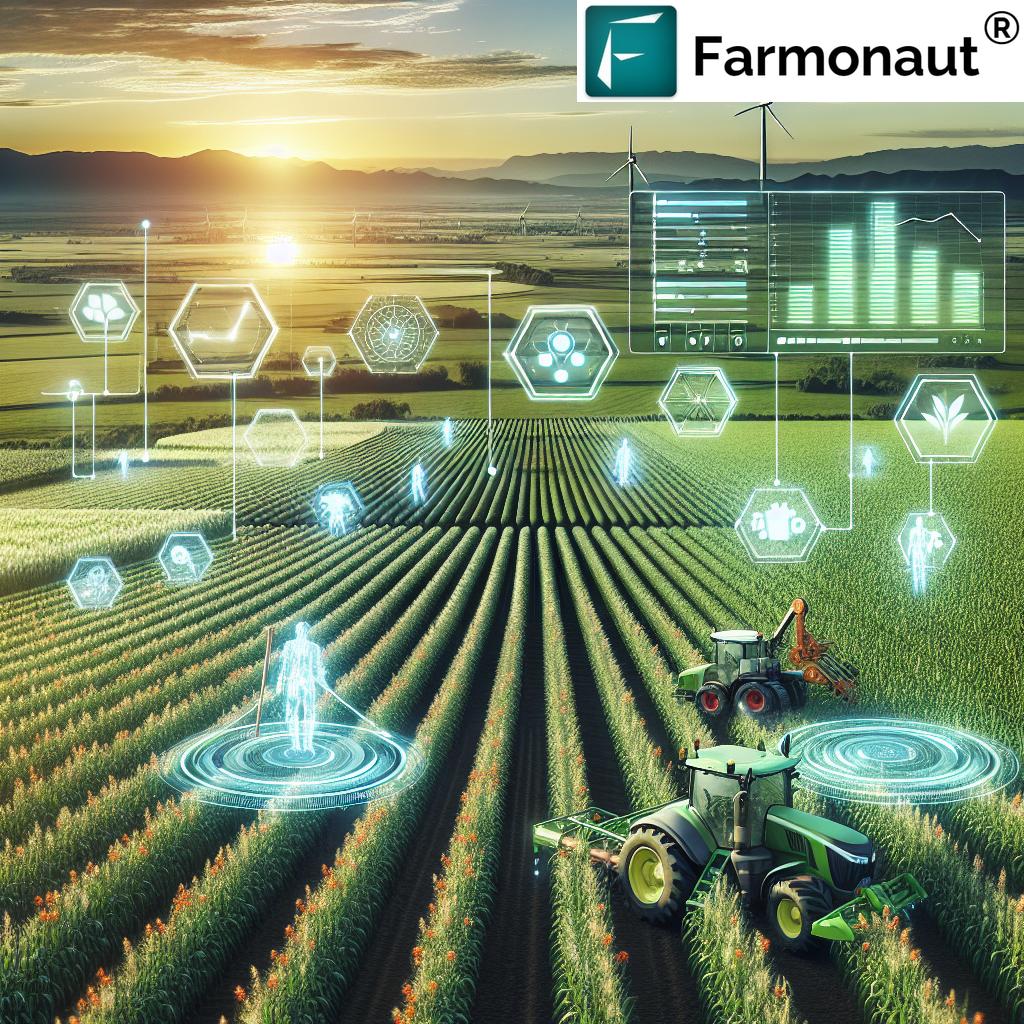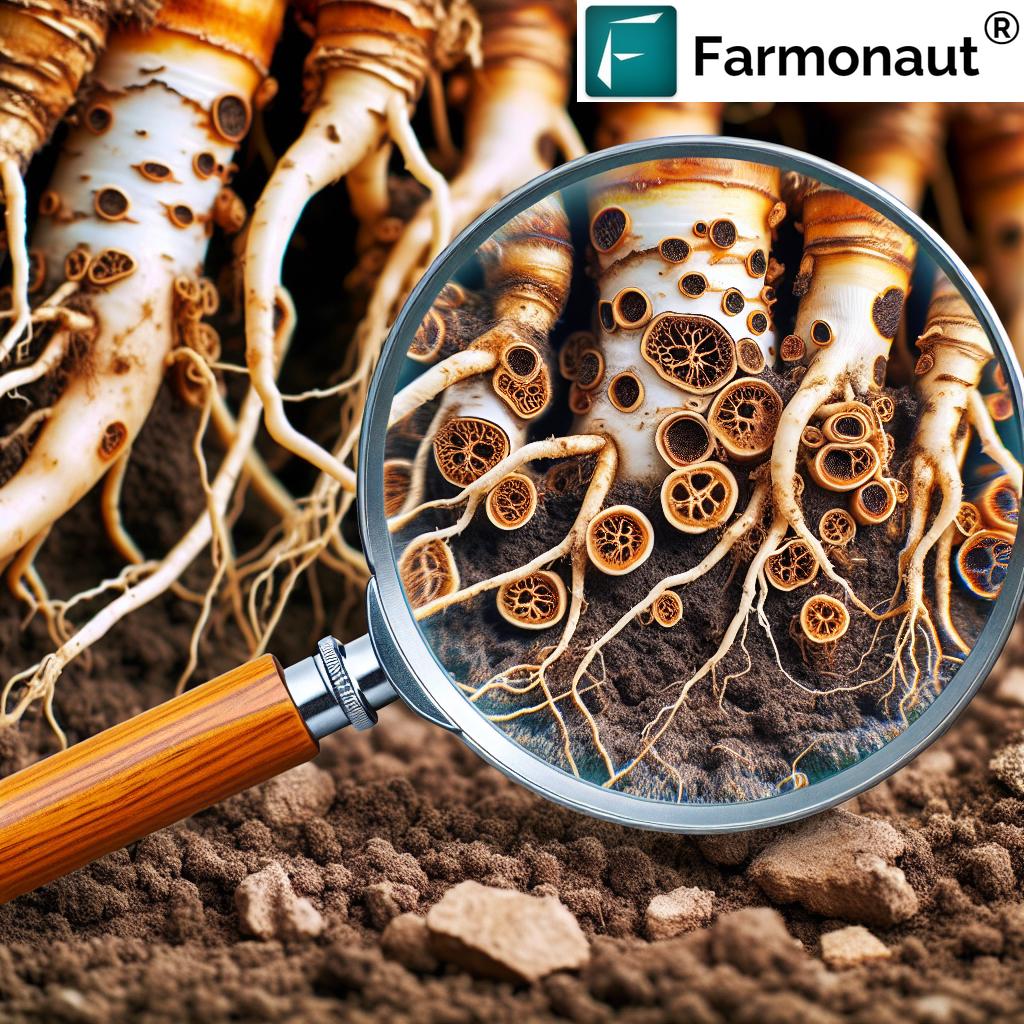Horticulture Yield & Soil Health: AI Breakthroughs for 2025
“AI-driven soil analysis in horticulture is projected to increase crop yields by up to 30% by 2025.”
Introduction: Horticulture Yield & Soil Health for 2025
Enhancing horticulture yield through soil health management in 2025 is at the forefront of the evolving landscape of agriculture. In horticulture—where the intensive cultivation of fruits, vegetables, and ornamental plants is practiced—soil health emerges as the fundamental factor determining crop productivity, sustainability, and environmental resilience. As we step into 2025, the importance of maintaining and improving soil health in agriculture is more pronounced than ever. Innovative technologies and advanced AI approaches are playing a pivotal role in boosting yield and ensuring long-term soil vitality.
This comprehensive guide explores what is soil health in agriculture, AI-driven solutions, key 2025 practices, and how organizations like Farmonaut are advancing soil, health, nutrient, horticulture, management, and yield on the path toward highly sustainable and profitable horticultural systems.
Read on to discover essential AI-powered strategies and solutions for a thriving horticultural future.
Understanding Soil Health in Agriculture: The Cornerstone of Horticultural Yield
At its core, soil health refers to the continued capacity of soil to function as a living ecosystem that sustains plants, animals, and humans. Soil health in agriculture determines our ability to raise healthy crops, especially when it comes to horticulture yield, soil health, and sustainable agriculture. But what is soil health in agriculture exactly? It’s about more than just nutrients; it’s about the structure, organic matter, moisture retention, microbial activity, and more.
- Rich in organic matter
- High microbial diversity: teeming with beneficial microorganisms
- Balanced nutrient content & pH levels
- Good soil structure and aeration
- Optimal moisture retention
Poor soil health manifests as nutrient depletion, compaction, erosion, reduced microbial activity, and increased susceptibility to pests and diseases—all leading to diminished horticulture yield and produce quality. Consequently, soil health u (soil health understanding) and managing soil health become a priority for farmers aiming to maximize productivity sustainably in 2025 and beyond.
“Over 60% of horticulture farms will adopt AI-based soil health monitoring systems by 2025.”
Key Factors Influencing Soil Health in Horticulture Yield Enhancement
Let’s break down the factors influencing soil health in horticulture and how they drive yield, quality, and environmental resilience:
-
Nutrient Balance
Soils must have an adequate supply of macro and micronutrients. Overuse or misuse of chemical fertilizers can disrupt nutrient cycles and harm beneficial soil life. Optimizing the balance—using AI to assess deficiencies and excesses—will be a key focus in 2025.
-
Organic Matter Content
Incorporating compost, cover crops, and green manures improves soil organic matter: enhancing moisture retention, nutrient availability, and soil structure.
-
Soil Microbial Diversity
Beneficial microbes like mycorrhizal fungi and nitrogen-fixing bacteria are essential for nutrient cycling and plant health. AI and sensors can now monitor microbial activity at unprecedented scales.
-
Soil pH and Texture
Optimal pH levels and the right soil texture (sandy, loam, clay) ensure nutrient availability and root development.
-
Structure, Aeration, and Compaction
The structure of the soil influences aeration, root growth, and the ability to hold water. Over-tillage or heavy machines may lead to soil compaction, reducing yields. AI-driven advisory tools alert farmers about compaction issues.
When Soil Health Declines: The Risks
- Poor soil health manifests as depletion, erosion, reduced microbial activity, increased susceptibility to pests and disease
- Directly reduce horticultural yields and produce quality
- Escalating input costs due to greater need for fertilizers and pesticides
- Decreased climate and environmental resilience of the land
Understanding and prioritizing these factors is critical for farmers and stakeholders aiming to maximize horticultural yields sustainably in 2025.
AI Breakthroughs Transforming Soil Health Management (2025)
In 2025, advanced AI for soil health systems and innovative technologies are pivotal to monitoring, boosting yields, and ensuring sustainable management of horticultural soils.
How AI for Soil Health is Revolutionizing Horticulture
-
Precision Nutrient Management:
- AI models analyze soil sensors, satellite imagery, and weather forecasts to anticipate nutrient deficiencies
- Recommends optimal fertilizer types and dosages to specific crop and soil needs
- Promotes reducing overuse of chemical fertilizers, improving nutrient availability, and decreasing environmental impact
-
Disease and Pest Prediction:
- AI correlates soil health data with historical pest and disease outbreaks
- Enables early, targeted intervention to protect yield quality and quantity
-
Soil Moisture & Aeration Monitoring:
- Integration of real-time soil moisture sensors and compaction detection
- Guides precise irrigation and tillage practices to maintain optimal soil conditions
-
Sustainable Crop Rotation Planning:
- AI designs and optimizes crop sequences that restore nutrients and break pest/disease cycles
- Enhances long-term soil fertility and yields
-
Integrated Soil Monitoring with Remote Sensing:
- Combining satellite-based data (Farmonaut’s Large-Scale Farm Management tools) with AI provides a field-to-continent view of soil health.
- Automated blockchain-based traceability (Farmonaut Traceability) improves supply chain authenticity and transparency.
-
Environmental Impact Tracking:
- AI models estimate carbon sequestration, emissions, and resource use. Farmonaut Carbon Footprinting helps producers improve their environmental credentials and unlock new market opportunities.
These AI approaches underpin the sustainable management and yield optimization of 2025—and will only expand in scope as technology advances.
Comparison Table: AI-Driven Horticultural Practices vs. Traditional Methods (2025)
Key Takeaways:
- AI-driven practices provide superior yield, improved soil health, water conservation, and sustainability benefits compared to traditional approaches.
- Integrating sensors, remote sensing, and AI-powered analytics will define the 2025 landscape for horticulture yield & soil health.
Essential Sustainable Soil Management Practices for 2025
Given the critical importance of soil health in agriculture and AI for soil health, what are the sustainable management practices and tech innovations that will shape horticulture yield and quality in 2025?
1. AI-Based Real-Time Soil Monitoring
- Advanced satellite-based solutions (as offered via Farmonaut’s platforms) deliver accurate, real-time soil nutrient and moisture profiles.
- API integration allows businesses to access satellite soil health data seamlessly—ideal for advanced agtech applications.
- Mobile and web accessibility via Farmonaut’s App ensures that individual farmers and agricultural enterprises alike can manage soil conditions remotely.
2. Dynamic Nutrient & Fertilizer Management
- AI interprets a multitude of soil sensor and satellite datasets to recommend precise fertilizer blends and dosages.
- Reduces fertilizers overuse/misuse, increases nutrient efficiency, and optimizes yields.
- Compliance with sustainability mandates and market requirements for low-chemical produce.
3. Integrated Moisture & Compaction Monitoring
- Using real-time soil moisture sensors and AI-linked irrigation management reduces water usage and avoids waterlogging risk.
- Compaction and aeration monitoring prevent root suffocation and support healthy root system development.
- Empowers irrigation scheduling and fertilization to maximize water productivity and crop health.
4. Intelligent Crop Planning & Rotation Strategies
- AI-powered analytics design multi-year crop sequences that are customized to the soil’s existing condition, nutrient history, and pest/disease cycles.
- Breaks cycles of persistent pests, enhances soil organic matter content, and optimizes long-term horticulture yield.
5. Blockchain-Enabled Traceability for Horticulture Produce
- Blockchain secures and verifies soil health data and farm practices at every stage.
- Farmonaut’s blockchain-based traceability platform gives buyers and consumers absolute confidence in food quality, safety, and sustainability.
6. Environmental Impact and Carbon Footprint Tracking
- Farmonaut Carbon Footprinting service enables farms and agribusinesses to monitor CO₂ emissions, soil carbon sequestration, and total environmental impact.
- Demonstrates a strong commitment to sustainable agricultural practices for markets, investors, and regulatory bodies in 2025.
7. API & Automation for Horticulture at Scale
- API access (see developer docs) lets tech-forward agribusinesses automate soil health monitoring, nutrient management, and traceability directly in their existing platforms.
- Fleet management solutions (Farmonaut Fleet Management) coordinate equipment use, minimizing soil compaction from overuse and optimizing asset deployment.
8. Improved Access to Crop Loans and Agricultural Insurance
- Satellite and AI-powered verification (Farmonaut Crop Loan and Insurance Verification) streamlines insurance and loan applications for crop producers, with a strong focus on soil health, yield prediction, and resilience.
9. Large-Scale, Remote Horticulture Management
- Our large-scale farm management platform (Farmonaut Agro Admin App) enables enterprises and governments to track soil health, yields, and sustainability over extensive geographies using satellite, AI, and blockchain.
- Delivers scalable, cost-effective results for horticultural and agricultural businesses in 2025.
Farmonaut’s Role: Satellite-Driven AI for Horticulture Yield & Soil Health
At Farmonaut, we believe the path forward in horticulture yield, soil health, and sustainable management is defined by cutting-edge technology. Our mission is to make satellite-driven, AI-powered insights and data solutions accessible for every farm, business, and government stakeholder globally.
Farmonaut Technologies for Soil Health & Yield in 2025:
-
Satellite Monitoring & Crop Health Analysis:
- Utilizing multispectral satellite imagery to deliver on-the-ground reports for soil health, crop development, disease, and pest risks.
-
Jeevn AI Advisory System:
- Delivers real-time, AI-generated actionable insights and weather forecasts for farmers and agribusinesses.
-
Carbon Footprint & Environmental Monitoring:
- Our environmental impact tracking tools help businesses reduce their carbon emissions and adopt climate-smart, sustainable agriculture (learn more).
-
Blockchain-Based Traceability:
- Product traceability solutions powered by blockchain ensure trust, transparency, and verification for every step of the horticultural supply chain (see details).
-
App & API Integrations:
- Access all our solutions through web/mobile apps or API endpoints—allowing scalable integration into business or government platforms.
Soil Health, Horticulture Yield, and Sustainability in 2025
The relationship between soil health, horticulture yield, and sustainability is more connected than ever in 2025:
- Healthy soils optimize water retention, nutrient cycling, and plant root growth, giving higher and higher-quality yields.
- AI technology ensures yields rise without depleting natural resources: conserving soil structure, moisture, and minimizing chemical leaching and run-off.
- Environmental resilience in horticulture farms increases—greater drought tolerance, less disease, and robust produce ready for premium markets.
- Data-driven sustainability actions set the standard for global food security and sustainable agriculture goals.
For those managing plantation, forestry, or large-scale horticulture landscapes, explore Farmonaut’s Crop Plantation & Forest Advisory tools—enabling best practices for soil health, biodiversity, and long-term yield in every habitat.
Frequently Asked Questions (FAQ) – Soil Health, AI & Horticulture Yield 2025
- What is soil health in agriculture, and why is it crucial for horticulture yield?
- Soil health in agriculture refers to the continued capacity of soil to function as a living ecosystem that sustains plants, animals, and humans. For horticultural crops, it’s essential because yield, quality, and environmental resilience directly depend on the soil’s nutrient content, structure, moisture retention, organic matter, and microbial activity.
- How does AI improve soil health and boost horticulture yield?
- AI leverages data from soil sensors, satellite imagery, and weather models to provide real-time insights into soil nutrient deficiencies, moisture levels, pest/disease risks, and optimal crop/rotation planning. This reduces overuse of chemicals, increases efficiency, and supports higher, more sustainable yields.
- What sustainability benefits do AI-driven soil health practices provide?
- AI-driven systems lead to healthier soils, reduce carbon footprints, optimize input use, cut water usage, and enable transparent traceability through blockchain, ensuring long-term environmental stewardship in horticulture.
- How can farmers or businesses leverage Farmonaut’s solutions?
- By using Farmonaut’s satellite, AI, and blockchain-powered platforms (web/mobile app or API), users can monitor soil health, receive customized advisories, manage carbon footprint, streamline crop loans and insurance, ensure supply chain traceability, and oversee large-scale operations efficiently.
- Which Farmonaut features support large-scale horticulture management?
- Our large-scale farm management, fleet management, and satellite monitoring modules empower businesses and governments to coordinate assets, monitor soil and crop health across wide areas, and meet global sustainability targets.
- Where can developers integrate Farmonaut data into their agri-tech solutions?
- Find Farmonaut API documentation and integration resources here.
Conclusion & Key Takeaways for Enhancing Horticulture Yield Through Soil Health in 2025
The 2025 horticultural landscape is defined by soil health management and the innovative integration of AI technologies—a combination that’s transforming how we produce food, manage land, and protect our planet.
- Horticulture yield and soil health are inseparable—their synergy is the foundation of resilient, sustainable agriculture.
- AI breakthroughs deliver actionable insights to balance nutrients, boost productivity, reduce wastage, and sustain soil vitality for generations.
- Farmonaut empowers users globally with the tools to unlock the full value of satellite, AI, and blockchain for horticulture, yield, and soil health—accessible via app, API, or modular platform.
Whether you are a farmer, agribusiness, or policymaker, prioritizing soil health management in horticulture with the latest AI-driven solutions is the surest path to higher yield, improved crop quality, and a more sustainable future in 2025 and beyond.
Try Farmonaut today to transform your soil health and yield strategy.












